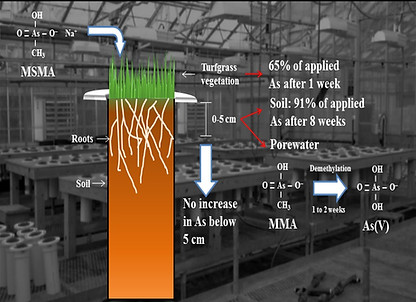Research
The overarching goal of our research program is to help better predict, manage and respond to contaminants that threaten human and environmental health. We strive to conduct usable science, linking fundamental concepts with applied outcomes, in order to inform management and policy decisions.
Contaminant distributions in soils, sediments and natural waters are controlled by a host of physical, chemical and biological processes, each of which can exert its influence over a range of spatial and temporal scales. In our research, we integrate multi-scale field, laboratory and spectroscopic approaches to better understand the sources and fate of contaminants in the environment. Current research themes include:
Aquifer Vulnerability to Contamination from Natural Sources

Natural sources of contaminants threaten well water quality worldwide. We seek to characterize solid-phase sources and isolate the fundamental mechanisms leading to contaminant mobilization. Recent and ongoing efforts have been focused on evaluating the controls on arsenic in groundwater of Southeast Asia, manganese in North Carolina, and fluoride and arsenic in central Mexico.
Linking Natural Geochemical Complexity to Contaminant Reactivity

Current modes of environmental assessment rely on broad landscape and subsurface features that may impact the fate and transport of contaminants. Although specific mineralogical and chemical properties of systems are important factors governing pollution potential, comprehensive geochemical analyses are not included in vulnerability assessments. We are currently developing coupled geochemical and statistical approaches to understand how mineralogical complexity and reactivity govern the sources, speciation, distributions and cycling of contaminants. Recent work has harnessed the natural chemical variability in sediments to assess how the specific mineralogy and redox reactivity of manganese oxides in aquifers regulate the arsenic pollution potential of groundwater.
Elemental Cycling in the Critical Zone

Soil mineral weathering plays key roles controlling the distribution and flux of elements through the Critical Zone. Few models exist for field-scale cycling of redox-active elements due to the impure nature of host mineral phases and difficulty in deconvolving the numerous overlapping processes that drive elemental distributions. Working in Oregon and North Carolina, we are developing coupled field and spectroscopic approaches for investigating the spatial profiles of redox-active elements and minerals in order to improve models for Critical Zone chemical evolution and elemental export.
Human Impacts on Trace-Element Distributions in Soils, Sediments and Waters

Human actions have the potential to introduce and redistribute toxic trace elements in the environment. With research in Oregon, North Carolina and Bangladesh, we are examining the impacts of agricultural and mining practices on trace-element transport within watersheds, loading to soils, leaching to groundwater, and uptake by plants.
Water Quality and Sanitation in Low-Income Countries

Studies on water quality and sanitation in low-income countries tend to focus on small numbers of indicator contaminants and isolated resource uses. In field and laboratory studies, we are developing new approaches that more comprehensively examine current and future microbiological and chemical threats to water quality. Using global data sets, we are also investigating linkages between sanitation strategies and water quality challenges.
